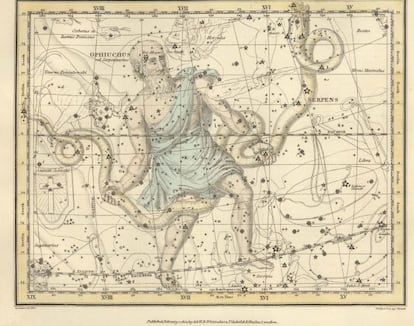Ophiuchus, the constellation that the astrologers chose to ignore
This overlooked group of stars raises the number of zodiac signs to 13, instead of 12

In January 1995, Jacqueline Mitton, from the British Royal Astronomical Society, announced in a BBC show that the 12 signs of the zodiac were not only erroneously advanced due to the effects of precession of the Earth, but that they were, in fact, 13. Mitton explained that the ecliptic (the Sun’s apparent annual journey through the heavens) passes through a thirteenth constellation: Ophiuchus – the Latin version of Asclepius, the Greek god of medicine. The ecliptic had actually always passed through that constellation, although the dates change with the centuries.
The astrologers, baffled, faced a problem: how to integrate this constellation as a sign of the zodiac.
To explain this astral blunder, we first have to clarify that a constellation is an “apparent” grouping of stars: they seem to be on the same plane, but they are actually at different distances and are not necessarily related to each other. By agreement, today it is each of the 88 areas in which the sky is divided, as well as the group of stars they contain. However, throughout history – beginning in Mesopotamia – the total number of constellations and the area they occupied varied, depending on the person who cataloged the stars. Then, between 1922 and 1930, the constellations were definitively established by the International Astronomical Union (IAU).
The astronomical zodiac is an imaginary belt that is distributed along the celestial equator and on which are located the 12 ancient constellations, of different sizes, designated with the names of the figures that their shapes inspired: a ram, a bull, Sagittarius the archer and so on. Ophiuchus – which Greek astronomer Ptolemy included among the 48 constellations of his treatise the Almagest – was probably not taken into account because, aside from the aversion to the number 13, dividing the 360-degree zodiacal band among 13 constellations would not have produced an exact number.
Meanwhile, the astrological zodiac is divided into 12 equal, 30-degree portions, each corresponding to a sign: Aries, Taurus, Gemini, Cancer, Leo, Virgo, Libra, Scorpio, Sagittarius, Capricorn, Aquarius and Pisces.
It was the Greek astronomer Hipparchus of Nicaea who, in the 2nd century BC, deduced that the Celestial Sphere had a retrograde motion, which he called precession. Due to the gravitational influence of the other bodies in the Solar System and the roundness of our planet, the Earth behaves like a spinning top in such a way that the relative positions of the stars with respect to the equator and the poles vary throughout a 26,000-year cycle, in which the Earth makes a complete revolution around the axis of the ecliptic.
However, the vindication of Ophiuchus as a zodiacal constellation between Scorpio and Sagittarius is not due to the precession, which only affects dates, but to the tracing of the classic celestial map and, above all, to the arbitrary division of the sky into constellations done by the IAU. Its name derives from Greek and means “he who holds the serpent.” This constellation is represented by the figure of Asclepius, who holds a snake in his hands, with its head facing west and its tail east.
Ophiuchus continues the legend of Orion and the Scorpion. The Greek myth tells that the hunting goddess Artemis wanted to take revenge on the hunter Orion, who boasted of being able to kill all wild beasts, in addition to continuously harassing the Pleiades, the seven nymphs turned into doves. For this, the goddess sent a scorpion that stung him on the heel, killing him with its poison. Then the gods moved both Orion and the scorpion to the heavens, but far apart, so they could never meet again. In fact, Orion hides as soon as the scorpion shows its pincers. As the scorpion ascends the eastern horizon, Orion dies and sets in the west. But Asclepius, with the healing powers that Apollo and Chiron taught him, cured the hunter and crushed the scorpion with his foot. Thus, Orion rises once more from the east, while the animal is crushed by the west.
Unfortunately, interest in astronomy still has an astrological component, with roots in antiquity. Astronomy and astrology were not conceptually differentiated until the 6th century AD, when Visigoth scholar Isidore of Seville established important distinctions between these two subjects in the third of his 20 Etymologiae books. According to the scholar, astronomy itself is dedicated to the abstract knowledge of the rising, setting and movement of the celestial bodies. As for astrology, he makes a distinction between “natural astrology,” which observes the path of the Sun and the Moon and certain positions of the stars, and a “superstitious astrology” that predicts the future through the stars, allocates part of the soul to one of the 12 signs of the heavens and arranges the birth and customs of humanity according to them.
“Superstitious astrology” – the alleged influences of the heavenly bodies on the lives and destinies of people – is what astrology means today. Isidore tells that the Chaldeans were the first to connect the observation to births, and that it was Abraham who instituted it among the Egyptians. And the confusion lasted for many centuries. Many important astronomical observations were made for astrological purposes. German astronomer Johannes Kepler himself had to dedicate himself to astrology out of necessity. He apologized for this lucrative activity by saying that, just as nature offered each being the means of subsistence, so it had put astrology as an aid to astronomy, as otherwise he would not have been able to get by.
The fact that Spain’s University of Salamanca kept the chair of “astrology” until the 17th century is further proof of how the lack of distinction between astronomers and astrologers persisted. It was in the 17th century, that astronomy and astrology were definitively divorced, adopting different meanings. Still, the etymological origin of the word astrology (“the science of the stars”) does not help to clarify the difference at all.
Real calendar of constellations
As a general rule, every year the Sun enters and leaves the constellations around these dates, although every four years there may be variations of hours that change them by one day.
Aries: April 21 - May 13
Taurus: May 14 - June 24
Gemini: June 25 - July 20
Cancer: July 21 - August 19
Leo: August 20 - September 14
Virgo: September 15 - October 31
Libra: November 1 - November 21
Scorpio: November 22 - November 29
Ophiuchus: November 30 - December 17
Sagittarius: December 18 - January 19
Capricorn: January 20 - February 15
Aquarius: February 16 - March 11
Pisces: March 12 - April 20
Tu suscripción se está usando en otro dispositivo
¿Quieres añadir otro usuario a tu suscripción?
Si continúas leyendo en este dispositivo, no se podrá leer en el otro.
FlechaTu suscripción se está usando en otro dispositivo y solo puedes acceder a EL PAÍS desde un dispositivo a la vez.
Si quieres compartir tu cuenta, cambia tu suscripción a la modalidad Premium, así podrás añadir otro usuario. Cada uno accederá con su propia cuenta de email, lo que os permitirá personalizar vuestra experiencia en EL PAÍS.
¿Tienes una suscripción de empresa? Accede aquí para contratar más cuentas.
En el caso de no saber quién está usando tu cuenta, te recomendamos cambiar tu contraseña aquí.
Si decides continuar compartiendo tu cuenta, este mensaje se mostrará en tu dispositivo y en el de la otra persona que está usando tu cuenta de forma indefinida, afectando a tu experiencia de lectura. Puedes consultar aquí los términos y condiciones de la suscripción digital.
More information
Últimas noticias
A survivor’s account of the Interoceanic Train accident: ‘We were scared because of the speed on the curve’
The Interoceanic Train, the Mexican alternative to the Panama Canal
What is known about the Interoceanic Train derailment in Oaxaca
Trump turns a Minnesota fraud allegation into ammunition for his MAGA army against Democrats
Most viewed
- Oona Chaplin: ‘I told James Cameron that I was living in a treehouse and starting a permaculture project with a friend’
- Reinhard Genzel, Nobel laureate in physics: ‘One-minute videos will never give you the truth’
- Why the price of coffee has skyrocketed: from Brazilian plantations to specialty coffee houses
- Pablo Escobar’s hippos: A serious environmental problem, 40 years on
- Chevy Chase, the beloved comedian who was a monster off camera: ‘Not everyone hated him, just the people who’ve worked with him’









































